Marketing Design and Innovation: Wrigley's Globalization Report
VerifiedAdded on 2021/01/02
|20
|6283
|182
Report
AI Summary
This report provides a comprehensive analysis of Wrigley's globalization and marketing strategies, focusing on the introduction of Orbit Drops. It critically examines the concept of globalization, evaluating the reasons for companies to go global and the key drivers influencing this process, including technological advancements, market dynamics, and cost considerations. The report assesses Wrigley's internal and external business environments, highlighting consumer trends and applying Maslow's hierarchy of needs. It explores the company's competitive advantages, both nationally and within the industry, while also considering the factors that facilitate internationalization, the associated issues and risks, and mitigation strategies. Furthermore, the report evaluates the global market potential for business expansion, analyzes market information, and suggests appropriate global segmentation, marketing mix, and communication strategies. It concludes with a discussion on the management of product and service innovation, methods for protecting innovation, and the risks of failing to do so, emphasizing the product's successful market performance and brand awareness.
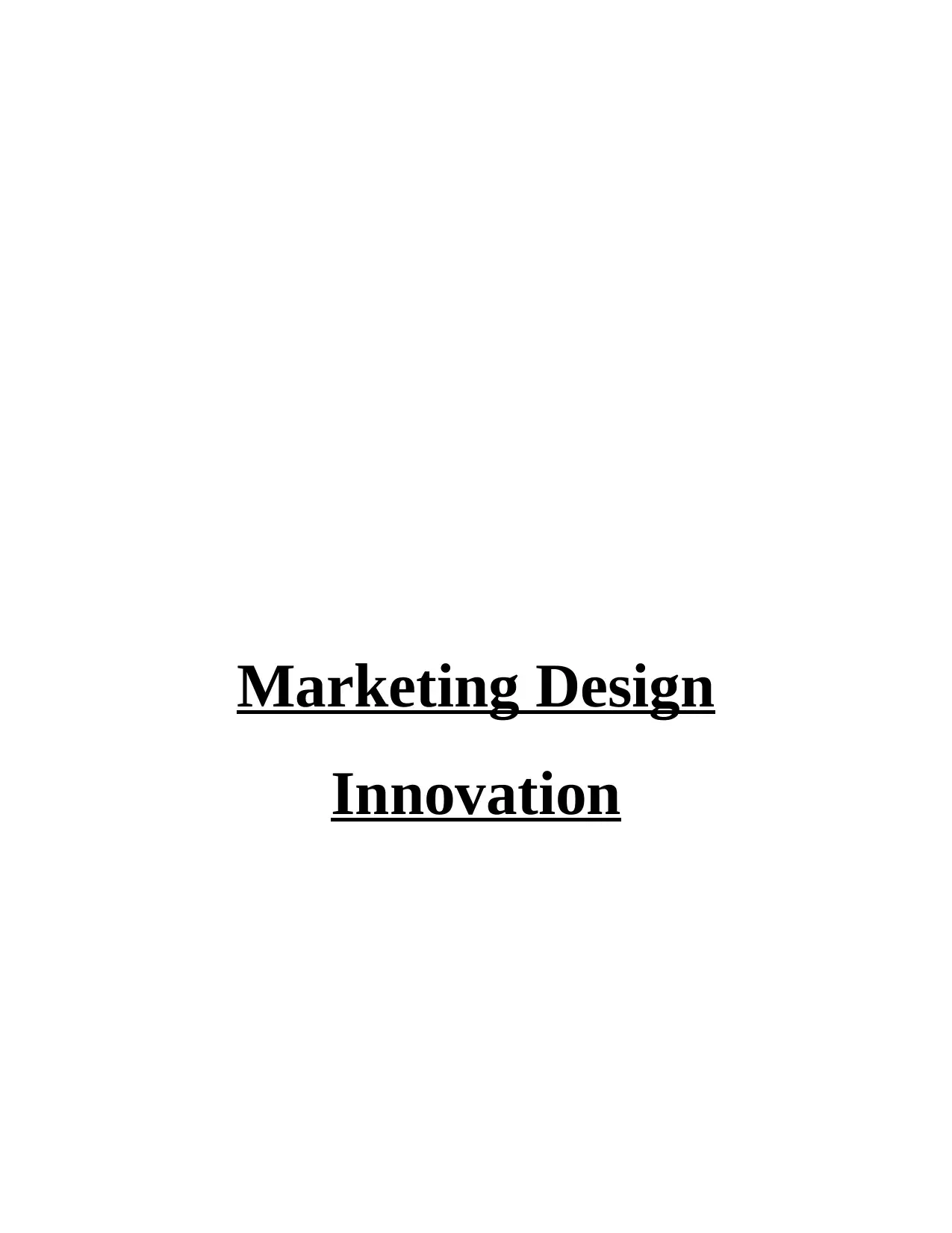
Marketing Design
Innovation
Innovation
Paraphrase This Document
Need a fresh take? Get an instant paraphrase of this document with our AI Paraphraser
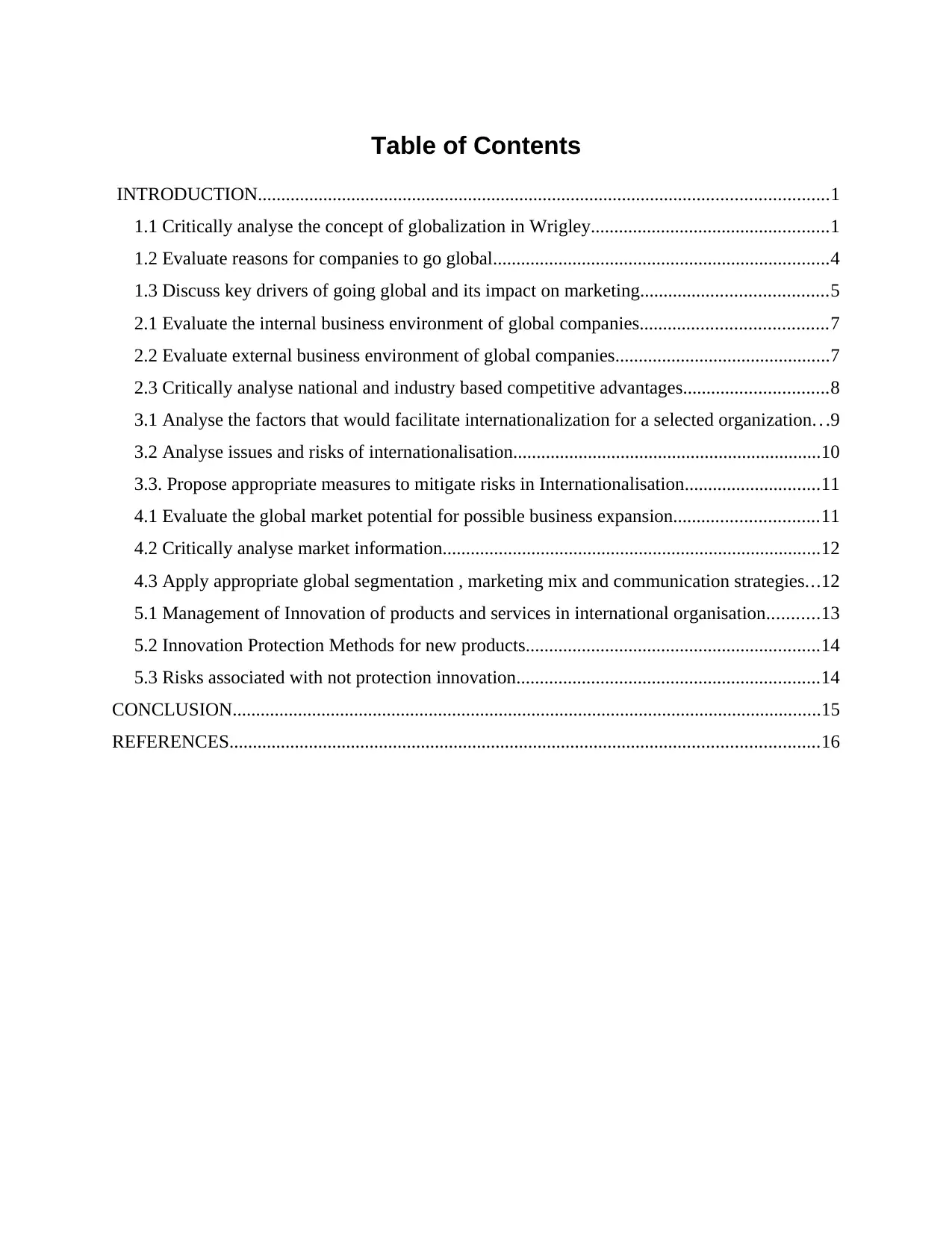
Table of Contents
INTRODUCTION..........................................................................................................................1
1.1 Critically analyse the concept of globalization in Wrigley...................................................1
1.2 Evaluate reasons for companies to go global........................................................................4
1.3 Discuss key drivers of going global and its impact on marketing........................................5
2.1 Evaluate the internal business environment of global companies........................................7
2.2 Evaluate external business environment of global companies..............................................7
2.3 Critically analyse national and industry based competitive advantages...............................8
3.1 Analyse the factors that would facilitate internationalization for a selected organization. . .9
3.2 Analyse issues and risks of internationalisation..................................................................10
3.3. Propose appropriate measures to mitigate risks in Internationalisation.............................11
4.1 Evaluate the global market potential for possible business expansion...............................11
4.2 Critically analyse market information.................................................................................12
4.3 Apply appropriate global segmentation , marketing mix and communication strategies...12
5.1 Management of Innovation of products and services in international organisation...........13
5.2 Innovation Protection Methods for new products...............................................................14
5.3 Risks associated with not protection innovation.................................................................14
CONCLUSION..............................................................................................................................15
REFERENCES..............................................................................................................................16
INTRODUCTION..........................................................................................................................1
1.1 Critically analyse the concept of globalization in Wrigley...................................................1
1.2 Evaluate reasons for companies to go global........................................................................4
1.3 Discuss key drivers of going global and its impact on marketing........................................5
2.1 Evaluate the internal business environment of global companies........................................7
2.2 Evaluate external business environment of global companies..............................................7
2.3 Critically analyse national and industry based competitive advantages...............................8
3.1 Analyse the factors that would facilitate internationalization for a selected organization. . .9
3.2 Analyse issues and risks of internationalisation..................................................................10
3.3. Propose appropriate measures to mitigate risks in Internationalisation.............................11
4.1 Evaluate the global market potential for possible business expansion...............................11
4.2 Critically analyse market information.................................................................................12
4.3 Apply appropriate global segmentation , marketing mix and communication strategies...12
5.1 Management of Innovation of products and services in international organisation...........13
5.2 Innovation Protection Methods for new products...............................................................14
5.3 Risks associated with not protection innovation.................................................................14
CONCLUSION..............................................................................................................................15
REFERENCES..............................................................................................................................16
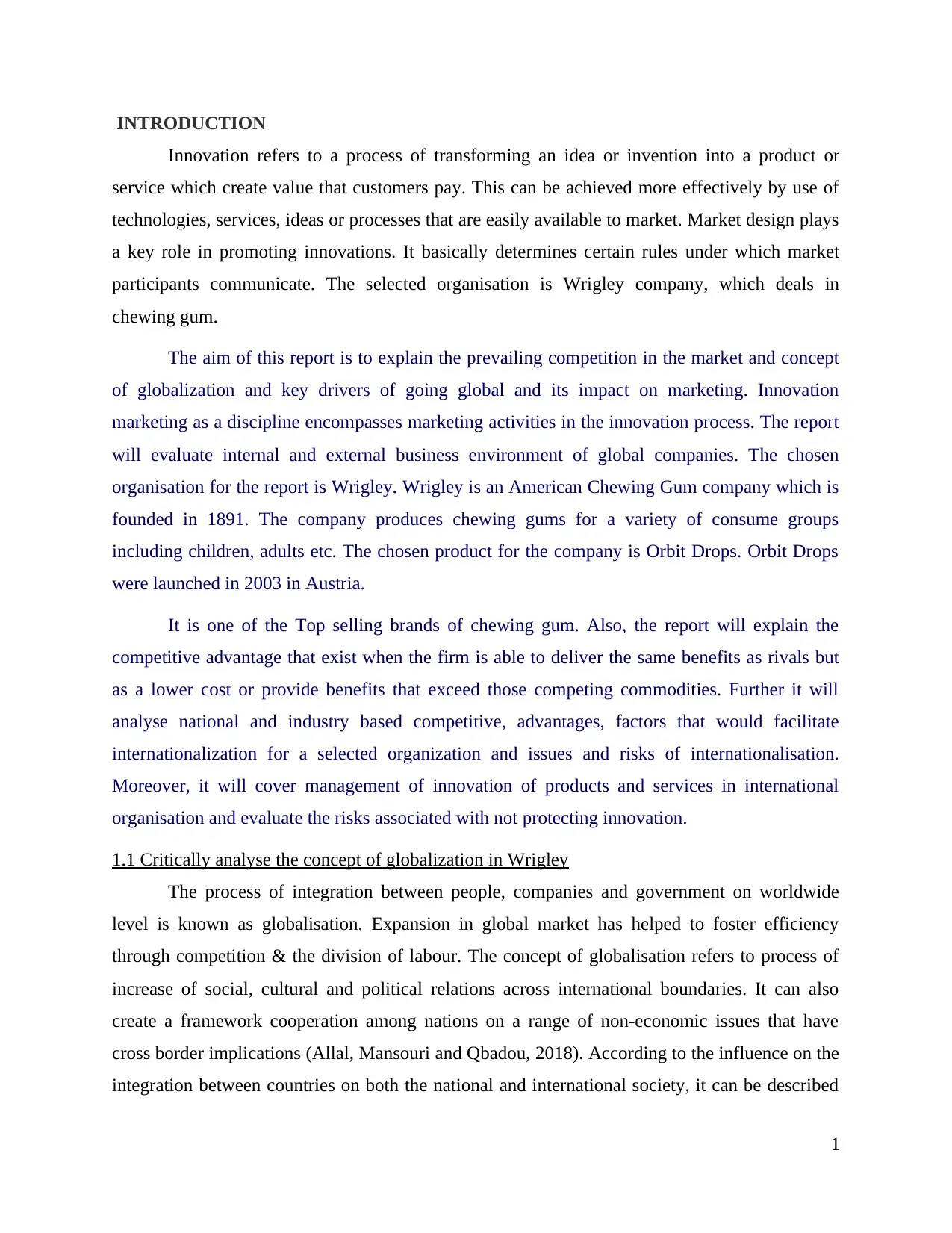
INTRODUCTION
Innovation refers to a process of transforming an idea or invention into a product or
service which create value that customers pay. This can be achieved more effectively by use of
technologies, services, ideas or processes that are easily available to market. Market design plays
a key role in promoting innovations. It basically determines certain rules under which market
participants communicate. The selected organisation is Wrigley company, which deals in
chewing gum.
The aim of this report is to explain the prevailing competition in the market and concept
of globalization and key drivers of going global and its impact on marketing. Innovation
marketing as a discipline encompasses marketing activities in the innovation process. The report
will evaluate internal and external business environment of global companies. The chosen
organisation for the report is Wrigley. Wrigley is an American Chewing Gum company which is
founded in 1891. The company produces chewing gums for a variety of consume groups
including children, adults etc. The chosen product for the company is Orbit Drops. Orbit Drops
were launched in 2003 in Austria.
It is one of the Top selling brands of chewing gum. Also, the report will explain the
competitive advantage that exist when the firm is able to deliver the same benefits as rivals but
as a lower cost or provide benefits that exceed those competing commodities. Further it will
analyse national and industry based competitive, advantages, factors that would facilitate
internationalization for a selected organization and issues and risks of internationalisation.
Moreover, it will cover management of innovation of products and services in international
organisation and evaluate the risks associated with not protecting innovation.
1.1 Critically analyse the concept of globalization in Wrigley
The process of integration between people, companies and government on worldwide
level is known as globalisation. Expansion in global market has helped to foster efficiency
through competition & the division of labour. The concept of globalisation refers to process of
increase of social, cultural and political relations across international boundaries. It can also
create a framework cooperation among nations on a range of non-economic issues that have
cross border implications (Allal, Mansouri and Qbadou, 2018). According to the influence on the
integration between countries on both the national and international society, it can be described
1
Innovation refers to a process of transforming an idea or invention into a product or
service which create value that customers pay. This can be achieved more effectively by use of
technologies, services, ideas or processes that are easily available to market. Market design plays
a key role in promoting innovations. It basically determines certain rules under which market
participants communicate. The selected organisation is Wrigley company, which deals in
chewing gum.
The aim of this report is to explain the prevailing competition in the market and concept
of globalization and key drivers of going global and its impact on marketing. Innovation
marketing as a discipline encompasses marketing activities in the innovation process. The report
will evaluate internal and external business environment of global companies. The chosen
organisation for the report is Wrigley. Wrigley is an American Chewing Gum company which is
founded in 1891. The company produces chewing gums for a variety of consume groups
including children, adults etc. The chosen product for the company is Orbit Drops. Orbit Drops
were launched in 2003 in Austria.
It is one of the Top selling brands of chewing gum. Also, the report will explain the
competitive advantage that exist when the firm is able to deliver the same benefits as rivals but
as a lower cost or provide benefits that exceed those competing commodities. Further it will
analyse national and industry based competitive, advantages, factors that would facilitate
internationalization for a selected organization and issues and risks of internationalisation.
Moreover, it will cover management of innovation of products and services in international
organisation and evaluate the risks associated with not protecting innovation.
1.1 Critically analyse the concept of globalization in Wrigley
The process of integration between people, companies and government on worldwide
level is known as globalisation. Expansion in global market has helped to foster efficiency
through competition & the division of labour. The concept of globalisation refers to process of
increase of social, cultural and political relations across international boundaries. It can also
create a framework cooperation among nations on a range of non-economic issues that have
cross border implications (Allal, Mansouri and Qbadou, 2018). According to the influence on the
integration between countries on both the national and international society, it can be described
1
⊘ This is a preview!⊘
Do you want full access?
Subscribe today to unlock all pages.

Trusted by 1+ million students worldwide
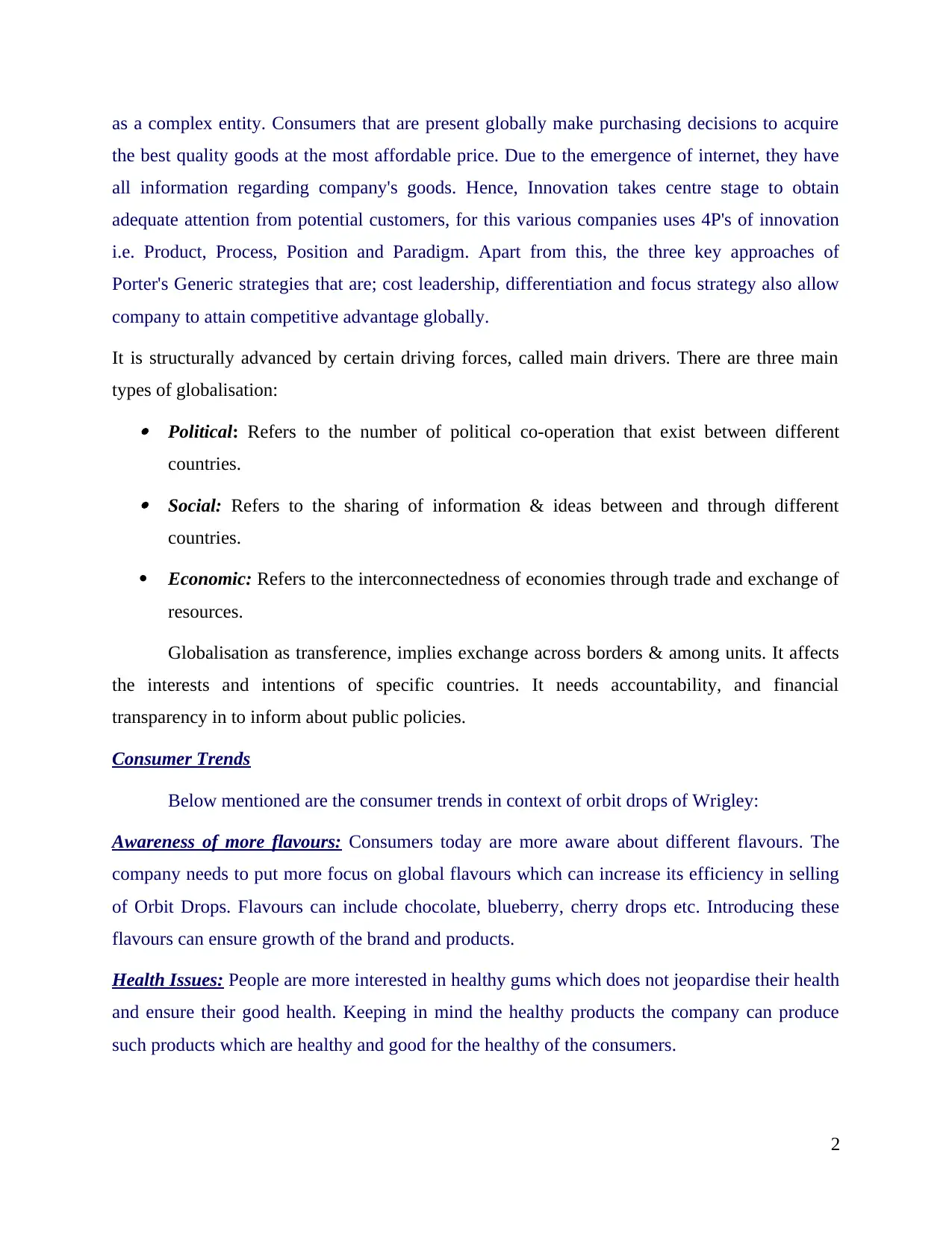
as a complex entity. Consumers that are present globally make purchasing decisions to acquire
the best quality goods at the most affordable price. Due to the emergence of internet, they have
all information regarding company's goods. Hence, Innovation takes centre stage to obtain
adequate attention from potential customers, for this various companies uses 4P's of innovation
i.e. Product, Process, Position and Paradigm. Apart from this, the three key approaches of
Porter's Generic strategies that are; cost leadership, differentiation and focus strategy also allow
company to attain competitive advantage globally.
It is structurally advanced by certain driving forces, called main drivers. There are three main
types of globalisation: Political: Refers to the number of political co-operation that exist between different
countries. Social: Refers to the sharing of information & ideas between and through different
countries.
Economic: Refers to the interconnectedness of economies through trade and exchange of
resources.
Globalisation as transference, implies exchange across borders & among units. It affects
the interests and intentions of specific countries. It needs accountability, and financial
transparency in to inform about public policies.
Consumer Trends
Below mentioned are the consumer trends in context of orbit drops of Wrigley:
Awareness of more flavours: Consumers today are more aware about different flavours. The
company needs to put more focus on global flavours which can increase its efficiency in selling
of Orbit Drops. Flavours can include chocolate, blueberry, cherry drops etc. Introducing these
flavours can ensure growth of the brand and products.
Health Issues: People are more interested in healthy gums which does not jeopardise their health
and ensure their good health. Keeping in mind the healthy products the company can produce
such products which are healthy and good for the healthy of the consumers.
2
the best quality goods at the most affordable price. Due to the emergence of internet, they have
all information regarding company's goods. Hence, Innovation takes centre stage to obtain
adequate attention from potential customers, for this various companies uses 4P's of innovation
i.e. Product, Process, Position and Paradigm. Apart from this, the three key approaches of
Porter's Generic strategies that are; cost leadership, differentiation and focus strategy also allow
company to attain competitive advantage globally.
It is structurally advanced by certain driving forces, called main drivers. There are three main
types of globalisation: Political: Refers to the number of political co-operation that exist between different
countries. Social: Refers to the sharing of information & ideas between and through different
countries.
Economic: Refers to the interconnectedness of economies through trade and exchange of
resources.
Globalisation as transference, implies exchange across borders & among units. It affects
the interests and intentions of specific countries. It needs accountability, and financial
transparency in to inform about public policies.
Consumer Trends
Below mentioned are the consumer trends in context of orbit drops of Wrigley:
Awareness of more flavours: Consumers today are more aware about different flavours. The
company needs to put more focus on global flavours which can increase its efficiency in selling
of Orbit Drops. Flavours can include chocolate, blueberry, cherry drops etc. Introducing these
flavours can ensure growth of the brand and products.
Health Issues: People are more interested in healthy gums which does not jeopardise their health
and ensure their good health. Keeping in mind the healthy products the company can produce
such products which are healthy and good for the healthy of the consumers.
2
Paraphrase This Document
Need a fresh take? Get an instant paraphrase of this document with our AI Paraphraser
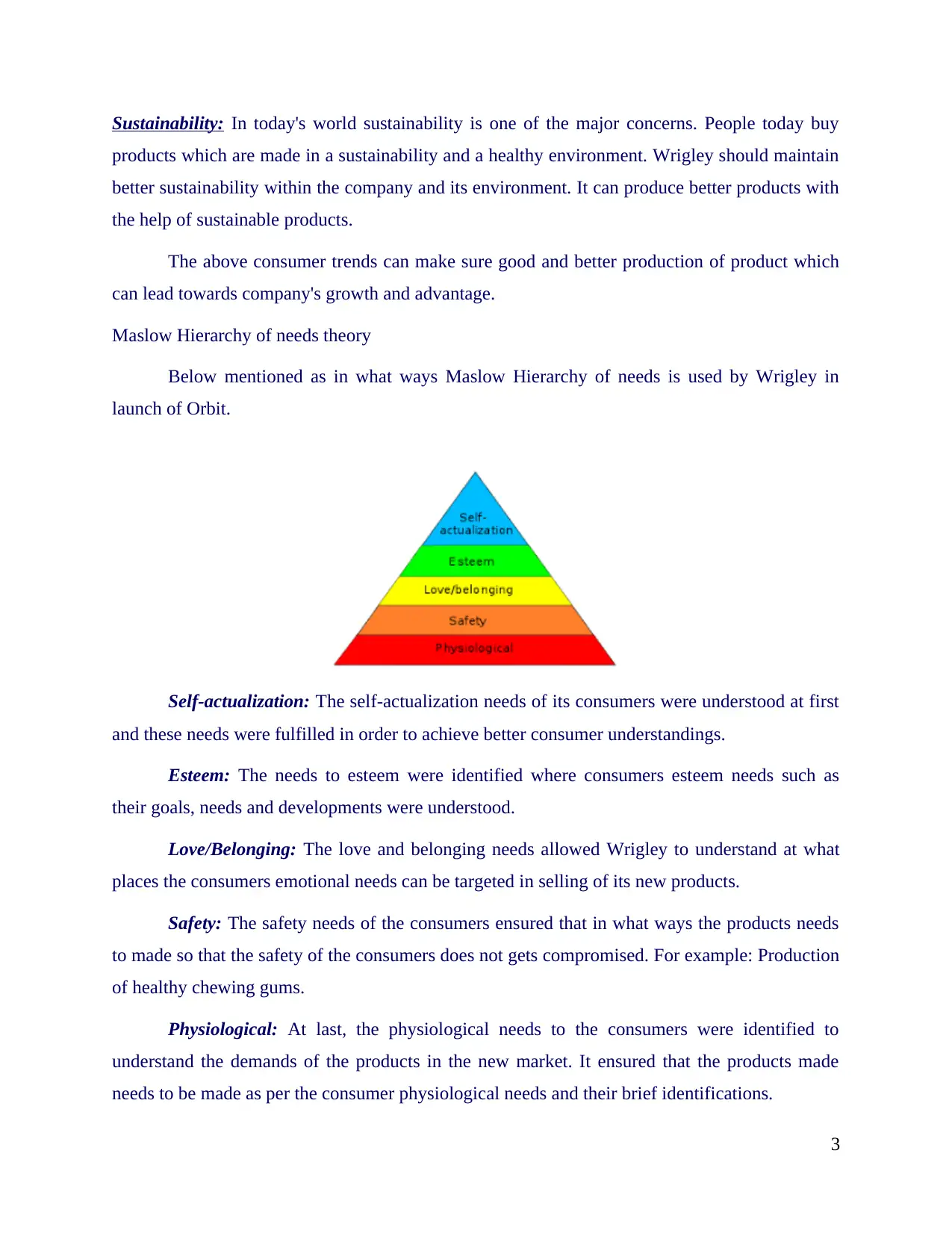
Sustainability: In today's world sustainability is one of the major concerns. People today buy
products which are made in a sustainability and a healthy environment. Wrigley should maintain
better sustainability within the company and its environment. It can produce better products with
the help of sustainable products.
The above consumer trends can make sure good and better production of product which
can lead towards company's growth and advantage.
Maslow Hierarchy of needs theory
Below mentioned as in what ways Maslow Hierarchy of needs is used by Wrigley in
launch of Orbit.
Self-actualization: The self-actualization needs of its consumers were understood at first
and these needs were fulfilled in order to achieve better consumer understandings.
Esteem: The needs to esteem were identified where consumers esteem needs such as
their goals, needs and developments were understood.
Love/Belonging: The love and belonging needs allowed Wrigley to understand at what
places the consumers emotional needs can be targeted in selling of its new products.
Safety: The safety needs of the consumers ensured that in what ways the products needs
to made so that the safety of the consumers does not gets compromised. For example: Production
of healthy chewing gums.
Physiological: At last, the physiological needs to the consumers were identified to
understand the demands of the products in the new market. It ensured that the products made
needs to be made as per the consumer physiological needs and their brief identifications.
3
products which are made in a sustainability and a healthy environment. Wrigley should maintain
better sustainability within the company and its environment. It can produce better products with
the help of sustainable products.
The above consumer trends can make sure good and better production of product which
can lead towards company's growth and advantage.
Maslow Hierarchy of needs theory
Below mentioned as in what ways Maslow Hierarchy of needs is used by Wrigley in
launch of Orbit.
Self-actualization: The self-actualization needs of its consumers were understood at first
and these needs were fulfilled in order to achieve better consumer understandings.
Esteem: The needs to esteem were identified where consumers esteem needs such as
their goals, needs and developments were understood.
Love/Belonging: The love and belonging needs allowed Wrigley to understand at what
places the consumers emotional needs can be targeted in selling of its new products.
Safety: The safety needs of the consumers ensured that in what ways the products needs
to made so that the safety of the consumers does not gets compromised. For example: Production
of healthy chewing gums.
Physiological: At last, the physiological needs to the consumers were identified to
understand the demands of the products in the new market. It ensured that the products made
needs to be made as per the consumer physiological needs and their brief identifications.
3
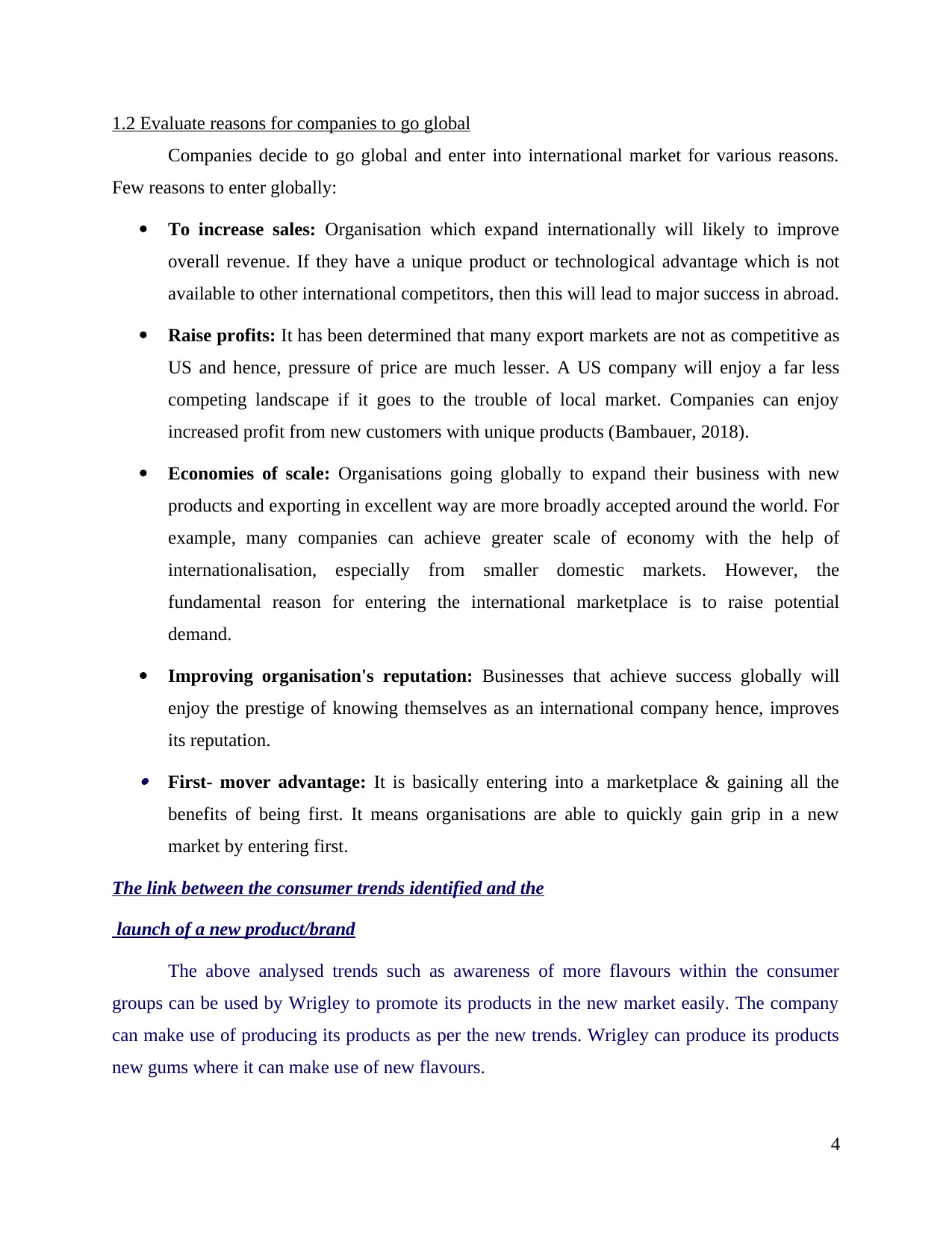
1.2 Evaluate reasons for companies to go global
Companies decide to go global and enter into international market for various reasons.
Few reasons to enter globally:
To increase sales: Organisation which expand internationally will likely to improve
overall revenue. If they have a unique product or technological advantage which is not
available to other international competitors, then this will lead to major success in abroad.
Raise profits: It has been determined that many export markets are not as competitive as
US and hence, pressure of price are much lesser. A US company will enjoy a far less
competing landscape if it goes to the trouble of local market. Companies can enjoy
increased profit from new customers with unique products (Bambauer, 2018).
Economies of scale: Organisations going globally to expand their business with new
products and exporting in excellent way are more broadly accepted around the world. For
example, many companies can achieve greater scale of economy with the help of
internationalisation, especially from smaller domestic markets. However, the
fundamental reason for entering the international marketplace is to raise potential
demand.
Improving organisation's reputation: Businesses that achieve success globally will
enjoy the prestige of knowing themselves as an international company hence, improves
its reputation. First- mover advantage: It is basically entering into a marketplace & gaining all the
benefits of being first. It means organisations are able to quickly gain grip in a new
market by entering first.
The link between the consumer trends identified and the
launch of a new product/brand
The above analysed trends such as awareness of more flavours within the consumer
groups can be used by Wrigley to promote its products in the new market easily. The company
can make use of producing its products as per the new trends. Wrigley can produce its products
new gums where it can make use of new flavours.
4
Companies decide to go global and enter into international market for various reasons.
Few reasons to enter globally:
To increase sales: Organisation which expand internationally will likely to improve
overall revenue. If they have a unique product or technological advantage which is not
available to other international competitors, then this will lead to major success in abroad.
Raise profits: It has been determined that many export markets are not as competitive as
US and hence, pressure of price are much lesser. A US company will enjoy a far less
competing landscape if it goes to the trouble of local market. Companies can enjoy
increased profit from new customers with unique products (Bambauer, 2018).
Economies of scale: Organisations going globally to expand their business with new
products and exporting in excellent way are more broadly accepted around the world. For
example, many companies can achieve greater scale of economy with the help of
internationalisation, especially from smaller domestic markets. However, the
fundamental reason for entering the international marketplace is to raise potential
demand.
Improving organisation's reputation: Businesses that achieve success globally will
enjoy the prestige of knowing themselves as an international company hence, improves
its reputation. First- mover advantage: It is basically entering into a marketplace & gaining all the
benefits of being first. It means organisations are able to quickly gain grip in a new
market by entering first.
The link between the consumer trends identified and the
launch of a new product/brand
The above analysed trends such as awareness of more flavours within the consumer
groups can be used by Wrigley to promote its products in the new market easily. The company
can make use of producing its products as per the new trends. Wrigley can produce its products
new gums where it can make use of new flavours.
4
⊘ This is a preview!⊘
Do you want full access?
Subscribe today to unlock all pages.

Trusted by 1+ million students worldwide
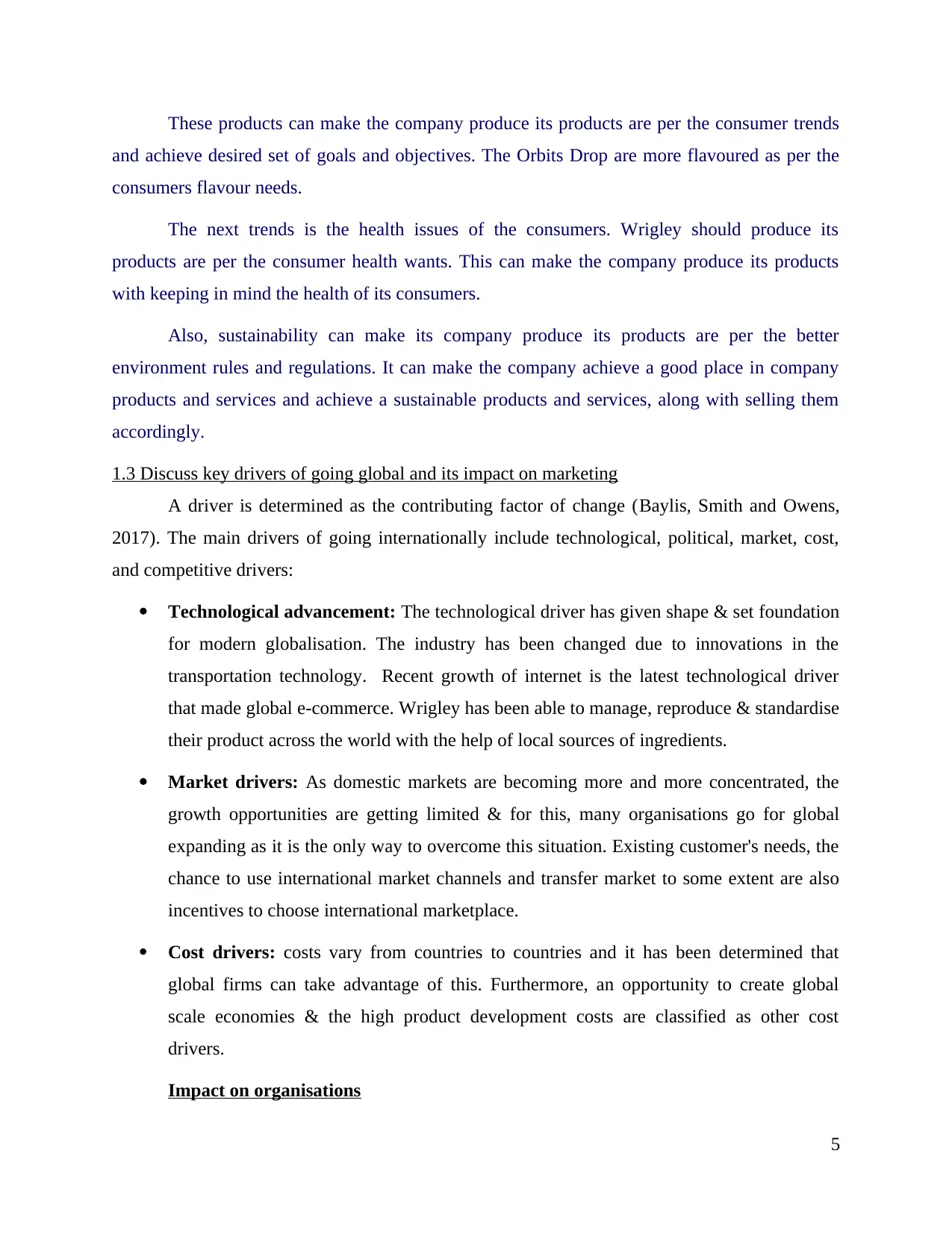
These products can make the company produce its products are per the consumer trends
and achieve desired set of goals and objectives. The Orbits Drop are more flavoured as per the
consumers flavour needs.
The next trends is the health issues of the consumers. Wrigley should produce its
products are per the consumer health wants. This can make the company produce its products
with keeping in mind the health of its consumers.
Also, sustainability can make its company produce its products are per the better
environment rules and regulations. It can make the company achieve a good place in company
products and services and achieve a sustainable products and services, along with selling them
accordingly.
1.3 Discuss key drivers of going global and its impact on marketing
A driver is determined as the contributing factor of change (Baylis, Smith and Owens,
2017). The main drivers of going internationally include technological, political, market, cost,
and competitive drivers:
Technological advancement: The technological driver has given shape & set foundation
for modern globalisation. The industry has been changed due to innovations in the
transportation technology. Recent growth of internet is the latest technological driver
that made global e-commerce. Wrigley has been able to manage, reproduce & standardise
their product across the world with the help of local sources of ingredients.
Market drivers: As domestic markets are becoming more and more concentrated, the
growth opportunities are getting limited & for this, many organisations go for global
expanding as it is the only way to overcome this situation. Existing customer's needs, the
chance to use international market channels and transfer market to some extent are also
incentives to choose international marketplace.
Cost drivers: costs vary from countries to countries and it has been determined that
global firms can take advantage of this. Furthermore, an opportunity to create global
scale economies & the high product development costs are classified as other cost
drivers.
Impact on organisations
5
and achieve desired set of goals and objectives. The Orbits Drop are more flavoured as per the
consumers flavour needs.
The next trends is the health issues of the consumers. Wrigley should produce its
products are per the consumer health wants. This can make the company produce its products
with keeping in mind the health of its consumers.
Also, sustainability can make its company produce its products are per the better
environment rules and regulations. It can make the company achieve a good place in company
products and services and achieve a sustainable products and services, along with selling them
accordingly.
1.3 Discuss key drivers of going global and its impact on marketing
A driver is determined as the contributing factor of change (Baylis, Smith and Owens,
2017). The main drivers of going internationally include technological, political, market, cost,
and competitive drivers:
Technological advancement: The technological driver has given shape & set foundation
for modern globalisation. The industry has been changed due to innovations in the
transportation technology. Recent growth of internet is the latest technological driver
that made global e-commerce. Wrigley has been able to manage, reproduce & standardise
their product across the world with the help of local sources of ingredients.
Market drivers: As domestic markets are becoming more and more concentrated, the
growth opportunities are getting limited & for this, many organisations go for global
expanding as it is the only way to overcome this situation. Existing customer's needs, the
chance to use international market channels and transfer market to some extent are also
incentives to choose international marketplace.
Cost drivers: costs vary from countries to countries and it has been determined that
global firms can take advantage of this. Furthermore, an opportunity to create global
scale economies & the high product development costs are classified as other cost
drivers.
Impact on organisations
5
Paraphrase This Document
Need a fresh take? Get an instant paraphrase of this document with our AI Paraphraser
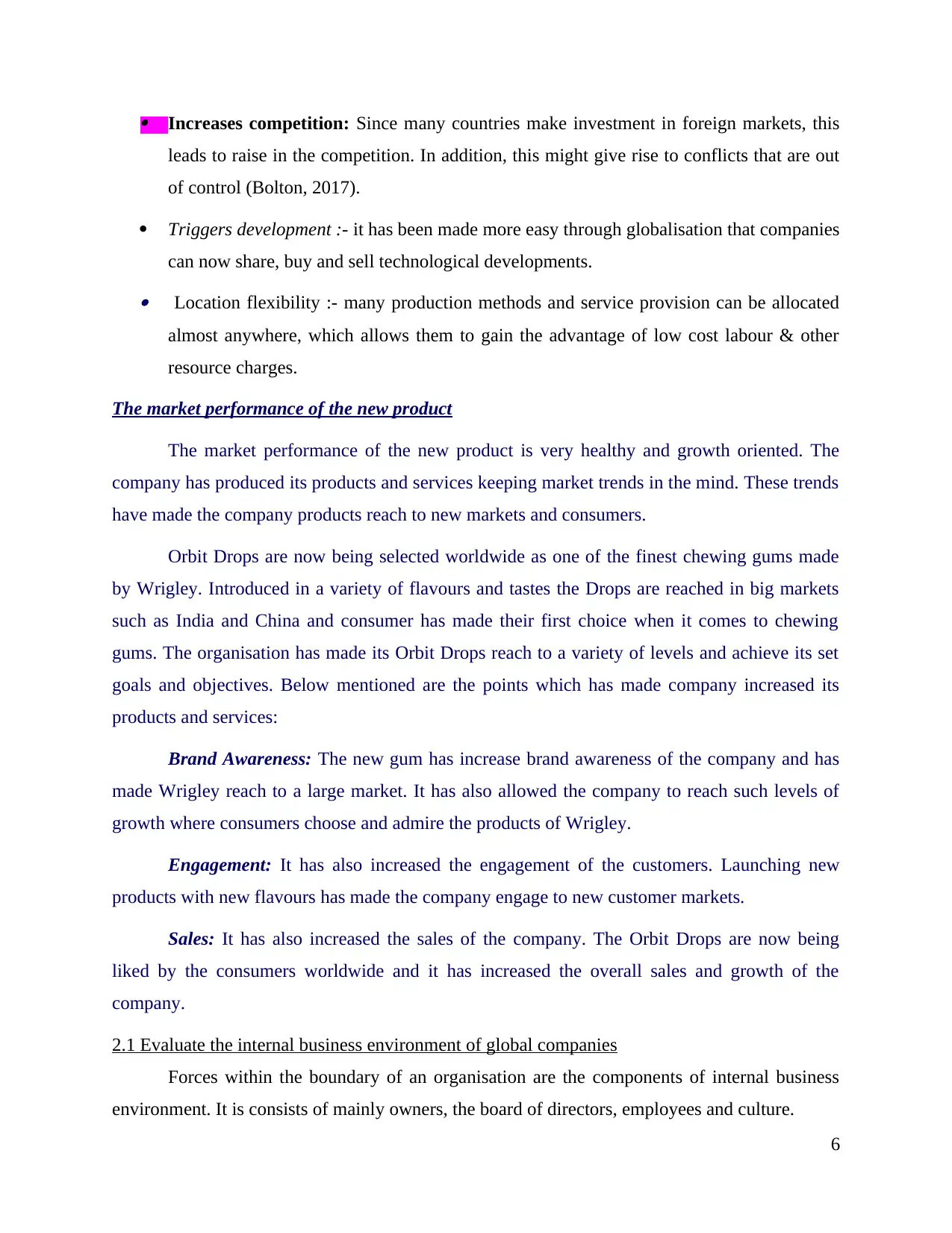
Increases competition: Since many countries make investment in foreign markets, this
leads to raise in the competition. In addition, this might give rise to conflicts that are out
of control (Bolton, 2017).
Triggers development :- it has been made more easy through globalisation that companies
can now share, buy and sell technological developments. Location flexibility :- many production methods and service provision can be allocated
almost anywhere, which allows them to gain the advantage of low cost labour & other
resource charges.
The market performance of the new product
The market performance of the new product is very healthy and growth oriented. The
company has produced its products and services keeping market trends in the mind. These trends
have made the company products reach to new markets and consumers.
Orbit Drops are now being selected worldwide as one of the finest chewing gums made
by Wrigley. Introduced in a variety of flavours and tastes the Drops are reached in big markets
such as India and China and consumer has made their first choice when it comes to chewing
gums. The organisation has made its Orbit Drops reach to a variety of levels and achieve its set
goals and objectives. Below mentioned are the points which has made company increased its
products and services:
Brand Awareness: The new gum has increase brand awareness of the company and has
made Wrigley reach to a large market. It has also allowed the company to reach such levels of
growth where consumers choose and admire the products of Wrigley.
Engagement: It has also increased the engagement of the customers. Launching new
products with new flavours has made the company engage to new customer markets.
Sales: It has also increased the sales of the company. The Orbit Drops are now being
liked by the consumers worldwide and it has increased the overall sales and growth of the
company.
2.1 Evaluate the internal business environment of global companies
Forces within the boundary of an organisation are the components of internal business
environment. It is consists of mainly owners, the board of directors, employees and culture.
6
leads to raise in the competition. In addition, this might give rise to conflicts that are out
of control (Bolton, 2017).
Triggers development :- it has been made more easy through globalisation that companies
can now share, buy and sell technological developments. Location flexibility :- many production methods and service provision can be allocated
almost anywhere, which allows them to gain the advantage of low cost labour & other
resource charges.
The market performance of the new product
The market performance of the new product is very healthy and growth oriented. The
company has produced its products and services keeping market trends in the mind. These trends
have made the company products reach to new markets and consumers.
Orbit Drops are now being selected worldwide as one of the finest chewing gums made
by Wrigley. Introduced in a variety of flavours and tastes the Drops are reached in big markets
such as India and China and consumer has made their first choice when it comes to chewing
gums. The organisation has made its Orbit Drops reach to a variety of levels and achieve its set
goals and objectives. Below mentioned are the points which has made company increased its
products and services:
Brand Awareness: The new gum has increase brand awareness of the company and has
made Wrigley reach to a large market. It has also allowed the company to reach such levels of
growth where consumers choose and admire the products of Wrigley.
Engagement: It has also increased the engagement of the customers. Launching new
products with new flavours has made the company engage to new customer markets.
Sales: It has also increased the sales of the company. The Orbit Drops are now being
liked by the consumers worldwide and it has increased the overall sales and growth of the
company.
2.1 Evaluate the internal business environment of global companies
Forces within the boundary of an organisation are the components of internal business
environment. It is consists of mainly owners, the board of directors, employees and culture.
6
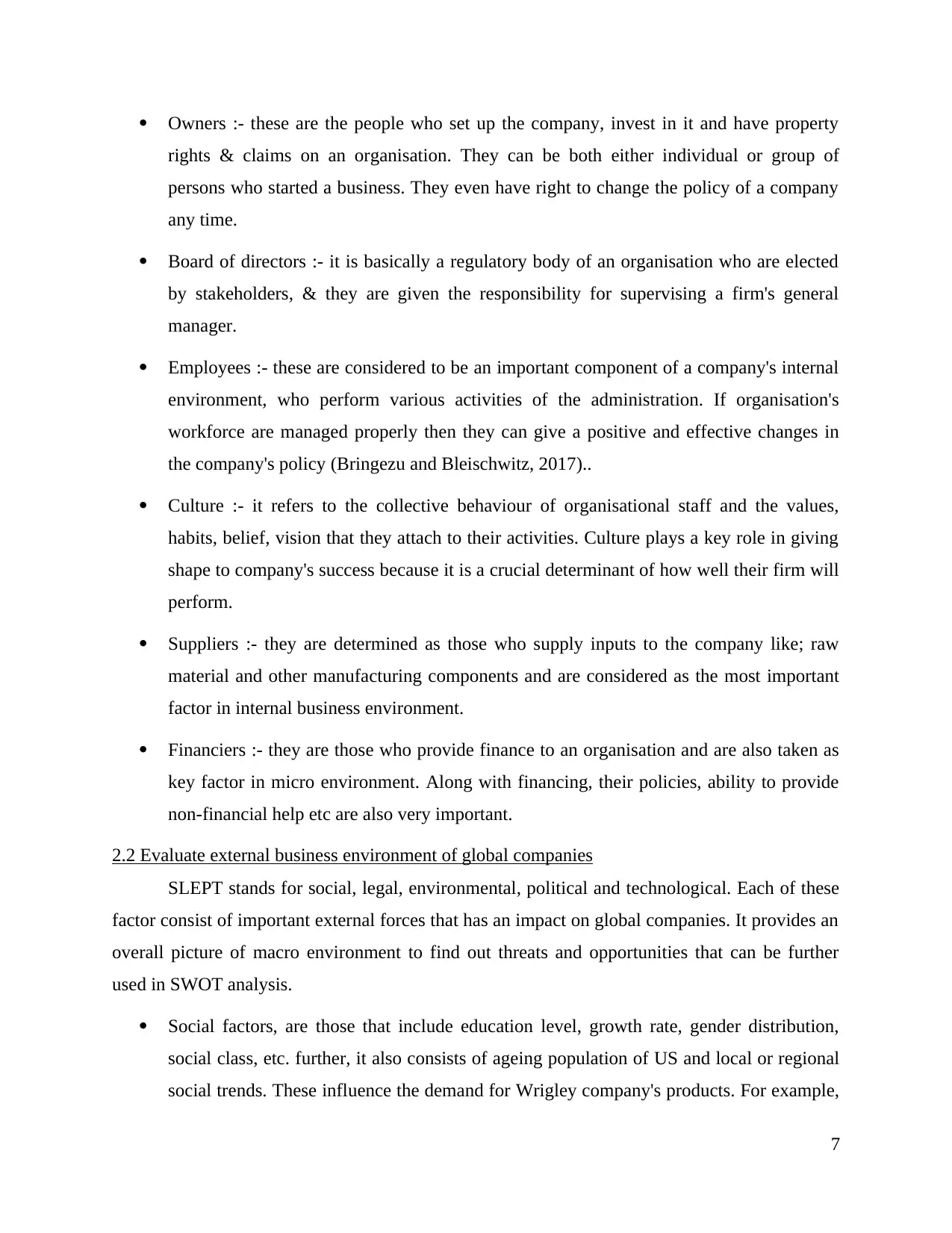
Owners :- these are the people who set up the company, invest in it and have property
rights & claims on an organisation. They can be both either individual or group of
persons who started a business. They even have right to change the policy of a company
any time.
Board of directors :- it is basically a regulatory body of an organisation who are elected
by stakeholders, & they are given the responsibility for supervising a firm's general
manager.
Employees :- these are considered to be an important component of a company's internal
environment, who perform various activities of the administration. If organisation's
workforce are managed properly then they can give a positive and effective changes in
the company's policy (Bringezu and Bleischwitz, 2017)..
Culture :- it refers to the collective behaviour of organisational staff and the values,
habits, belief, vision that they attach to their activities. Culture plays a key role in giving
shape to company's success because it is a crucial determinant of how well their firm will
perform.
Suppliers :- they are determined as those who supply inputs to the company like; raw
material and other manufacturing components and are considered as the most important
factor in internal business environment.
Financiers :- they are those who provide finance to an organisation and are also taken as
key factor in micro environment. Along with financing, their policies, ability to provide
non-financial help etc are also very important.
2.2 Evaluate external business environment of global companies
SLEPT stands for social, legal, environmental, political and technological. Each of these
factor consist of important external forces that has an impact on global companies. It provides an
overall picture of macro environment to find out threats and opportunities that can be further
used in SWOT analysis.
Social factors, are those that include education level, growth rate, gender distribution,
social class, etc. further, it also consists of ageing population of US and local or regional
social trends. These influence the demand for Wrigley company's products. For example,
7
rights & claims on an organisation. They can be both either individual or group of
persons who started a business. They even have right to change the policy of a company
any time.
Board of directors :- it is basically a regulatory body of an organisation who are elected
by stakeholders, & they are given the responsibility for supervising a firm's general
manager.
Employees :- these are considered to be an important component of a company's internal
environment, who perform various activities of the administration. If organisation's
workforce are managed properly then they can give a positive and effective changes in
the company's policy (Bringezu and Bleischwitz, 2017)..
Culture :- it refers to the collective behaviour of organisational staff and the values,
habits, belief, vision that they attach to their activities. Culture plays a key role in giving
shape to company's success because it is a crucial determinant of how well their firm will
perform.
Suppliers :- they are determined as those who supply inputs to the company like; raw
material and other manufacturing components and are considered as the most important
factor in internal business environment.
Financiers :- they are those who provide finance to an organisation and are also taken as
key factor in micro environment. Along with financing, their policies, ability to provide
non-financial help etc are also very important.
2.2 Evaluate external business environment of global companies
SLEPT stands for social, legal, environmental, political and technological. Each of these
factor consist of important external forces that has an impact on global companies. It provides an
overall picture of macro environment to find out threats and opportunities that can be further
used in SWOT analysis.
Social factors, are those that include education level, growth rate, gender distribution,
social class, etc. further, it also consists of ageing population of US and local or regional
social trends. These influence the demand for Wrigley company's products. For example,
7
⊘ This is a preview!⊘
Do you want full access?
Subscribe today to unlock all pages.

Trusted by 1+ million students worldwide
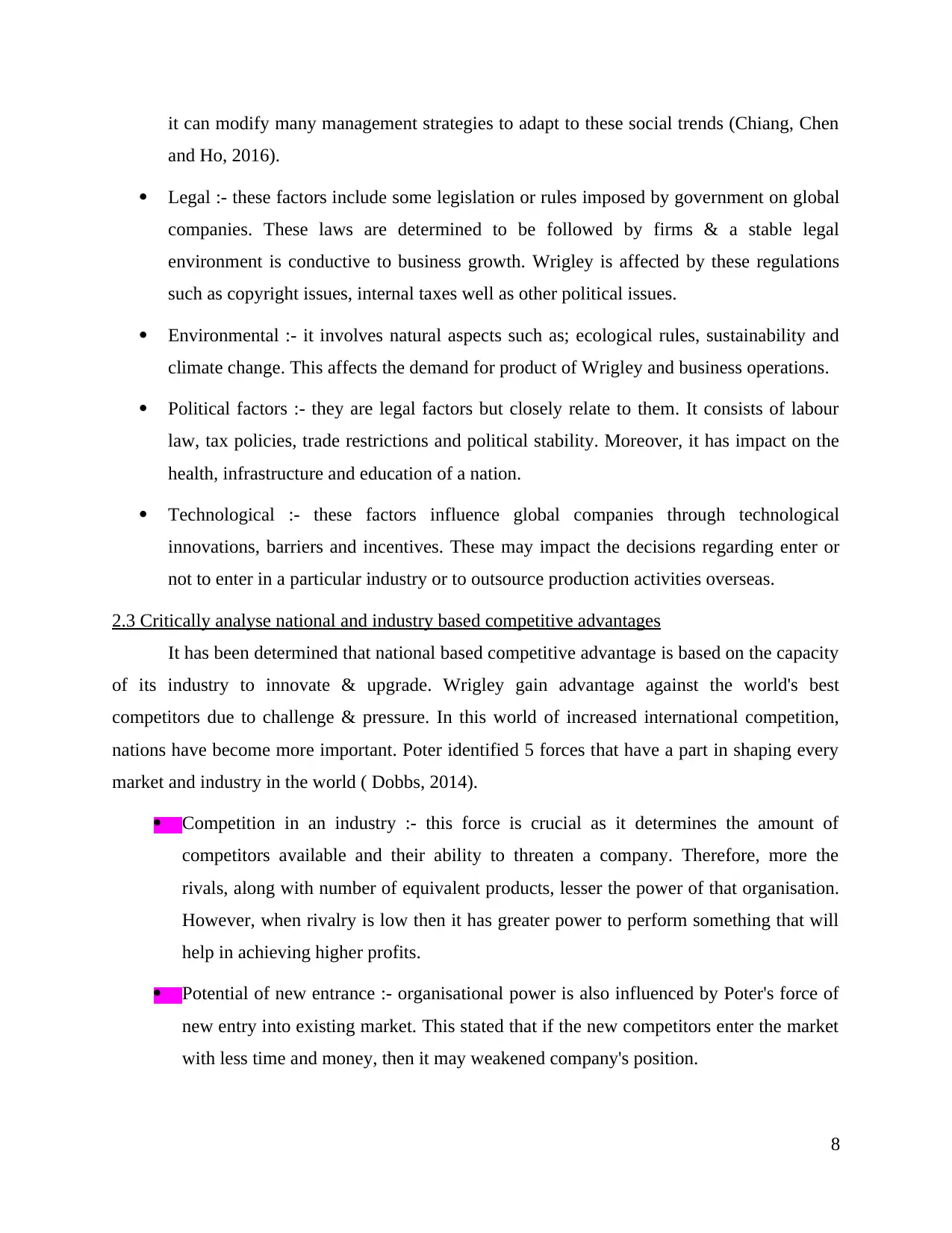
it can modify many management strategies to adapt to these social trends (Chiang, Chen
and Ho, 2016).
Legal :- these factors include some legislation or rules imposed by government on global
companies. These laws are determined to be followed by firms & a stable legal
environment is conductive to business growth. Wrigley is affected by these regulations
such as copyright issues, internal taxes well as other political issues.
Environmental :- it involves natural aspects such as; ecological rules, sustainability and
climate change. This affects the demand for product of Wrigley and business operations.
Political factors :- they are legal factors but closely relate to them. It consists of labour
law, tax policies, trade restrictions and political stability. Moreover, it has impact on the
health, infrastructure and education of a nation.
Technological :- these factors influence global companies through technological
innovations, barriers and incentives. These may impact the decisions regarding enter or
not to enter in a particular industry or to outsource production activities overseas.
2.3 Critically analyse national and industry based competitive advantages
It has been determined that national based competitive advantage is based on the capacity
of its industry to innovate & upgrade. Wrigley gain advantage against the world's best
competitors due to challenge & pressure. In this world of increased international competition,
nations have become more important. Poter identified 5 forces that have a part in shaping every
market and industry in the world ( Dobbs, 2014).
Competition in an industry :- this force is crucial as it determines the amount of
competitors available and their ability to threaten a company. Therefore, more the
rivals, along with number of equivalent products, lesser the power of that organisation.
However, when rivalry is low then it has greater power to perform something that will
help in achieving higher profits.
Potential of new entrance :- organisational power is also influenced by Poter's force of
new entry into existing market. This stated that if the new competitors enter the market
with less time and money, then it may weakened company's position.
8
and Ho, 2016).
Legal :- these factors include some legislation or rules imposed by government on global
companies. These laws are determined to be followed by firms & a stable legal
environment is conductive to business growth. Wrigley is affected by these regulations
such as copyright issues, internal taxes well as other political issues.
Environmental :- it involves natural aspects such as; ecological rules, sustainability and
climate change. This affects the demand for product of Wrigley and business operations.
Political factors :- they are legal factors but closely relate to them. It consists of labour
law, tax policies, trade restrictions and political stability. Moreover, it has impact on the
health, infrastructure and education of a nation.
Technological :- these factors influence global companies through technological
innovations, barriers and incentives. These may impact the decisions regarding enter or
not to enter in a particular industry or to outsource production activities overseas.
2.3 Critically analyse national and industry based competitive advantages
It has been determined that national based competitive advantage is based on the capacity
of its industry to innovate & upgrade. Wrigley gain advantage against the world's best
competitors due to challenge & pressure. In this world of increased international competition,
nations have become more important. Poter identified 5 forces that have a part in shaping every
market and industry in the world ( Dobbs, 2014).
Competition in an industry :- this force is crucial as it determines the amount of
competitors available and their ability to threaten a company. Therefore, more the
rivals, along with number of equivalent products, lesser the power of that organisation.
However, when rivalry is low then it has greater power to perform something that will
help in achieving higher profits.
Potential of new entrance :- organisational power is also influenced by Poter's force of
new entry into existing market. This stated that if the new competitors enter the market
with less time and money, then it may weakened company's position.
8
Paraphrase This Document
Need a fresh take? Get an instant paraphrase of this document with our AI Paraphraser
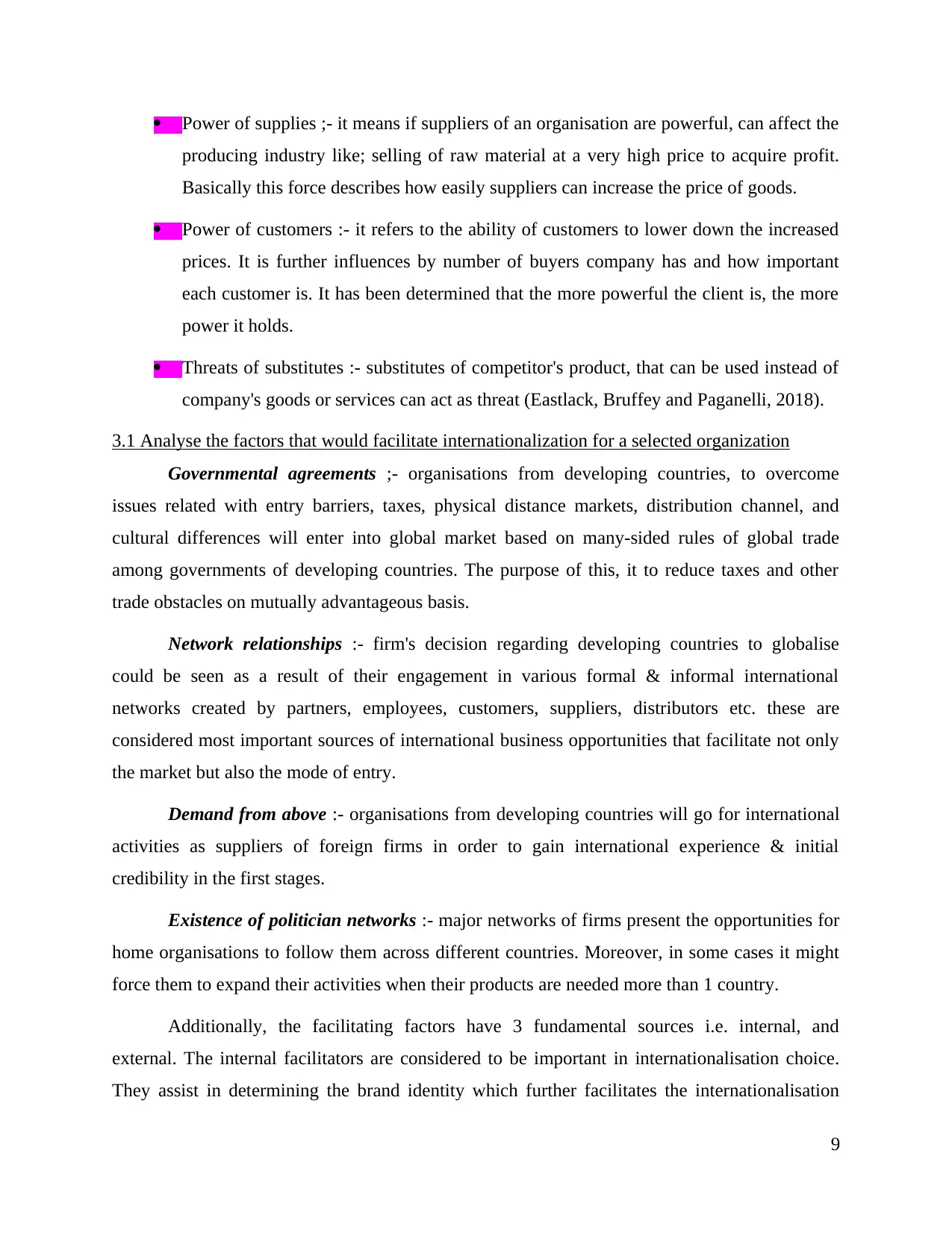
Power of supplies ;- it means if suppliers of an organisation are powerful, can affect the
producing industry like; selling of raw material at a very high price to acquire profit.
Basically this force describes how easily suppliers can increase the price of goods.
Power of customers :- it refers to the ability of customers to lower down the increased
prices. It is further influences by number of buyers company has and how important
each customer is. It has been determined that the more powerful the client is, the more
power it holds.
Threats of substitutes :- substitutes of competitor's product, that can be used instead of
company's goods or services can act as threat (Eastlack, Bruffey and Paganelli, 2018).
3.1 Analyse the factors that would facilitate internationalization for a selected organization
Governmental agreements ;- organisations from developing countries, to overcome
issues related with entry barriers, taxes, physical distance markets, distribution channel, and
cultural differences will enter into global market based on many-sided rules of global trade
among governments of developing countries. The purpose of this, it to reduce taxes and other
trade obstacles on mutually advantageous basis.
Network relationships :- firm's decision regarding developing countries to globalise
could be seen as a result of their engagement in various formal & informal international
networks created by partners, employees, customers, suppliers, distributors etc. these are
considered most important sources of international business opportunities that facilitate not only
the market but also the mode of entry.
Demand from above :- organisations from developing countries will go for international
activities as suppliers of foreign firms in order to gain international experience & initial
credibility in the first stages.
Existence of politician networks :- major networks of firms present the opportunities for
home organisations to follow them across different countries. Moreover, in some cases it might
force them to expand their activities when their products are needed more than 1 country.
Additionally, the facilitating factors have 3 fundamental sources i.e. internal, and
external. The internal facilitators are considered to be important in internationalisation choice.
They assist in determining the brand identity which further facilitates the internationalisation
9
producing industry like; selling of raw material at a very high price to acquire profit.
Basically this force describes how easily suppliers can increase the price of goods.
Power of customers :- it refers to the ability of customers to lower down the increased
prices. It is further influences by number of buyers company has and how important
each customer is. It has been determined that the more powerful the client is, the more
power it holds.
Threats of substitutes :- substitutes of competitor's product, that can be used instead of
company's goods or services can act as threat (Eastlack, Bruffey and Paganelli, 2018).
3.1 Analyse the factors that would facilitate internationalization for a selected organization
Governmental agreements ;- organisations from developing countries, to overcome
issues related with entry barriers, taxes, physical distance markets, distribution channel, and
cultural differences will enter into global market based on many-sided rules of global trade
among governments of developing countries. The purpose of this, it to reduce taxes and other
trade obstacles on mutually advantageous basis.
Network relationships :- firm's decision regarding developing countries to globalise
could be seen as a result of their engagement in various formal & informal international
networks created by partners, employees, customers, suppliers, distributors etc. these are
considered most important sources of international business opportunities that facilitate not only
the market but also the mode of entry.
Demand from above :- organisations from developing countries will go for international
activities as suppliers of foreign firms in order to gain international experience & initial
credibility in the first stages.
Existence of politician networks :- major networks of firms present the opportunities for
home organisations to follow them across different countries. Moreover, in some cases it might
force them to expand their activities when their products are needed more than 1 country.
Additionally, the facilitating factors have 3 fundamental sources i.e. internal, and
external. The internal facilitators are considered to be important in internationalisation choice.
They assist in determining the brand identity which further facilitates the internationalisation
9
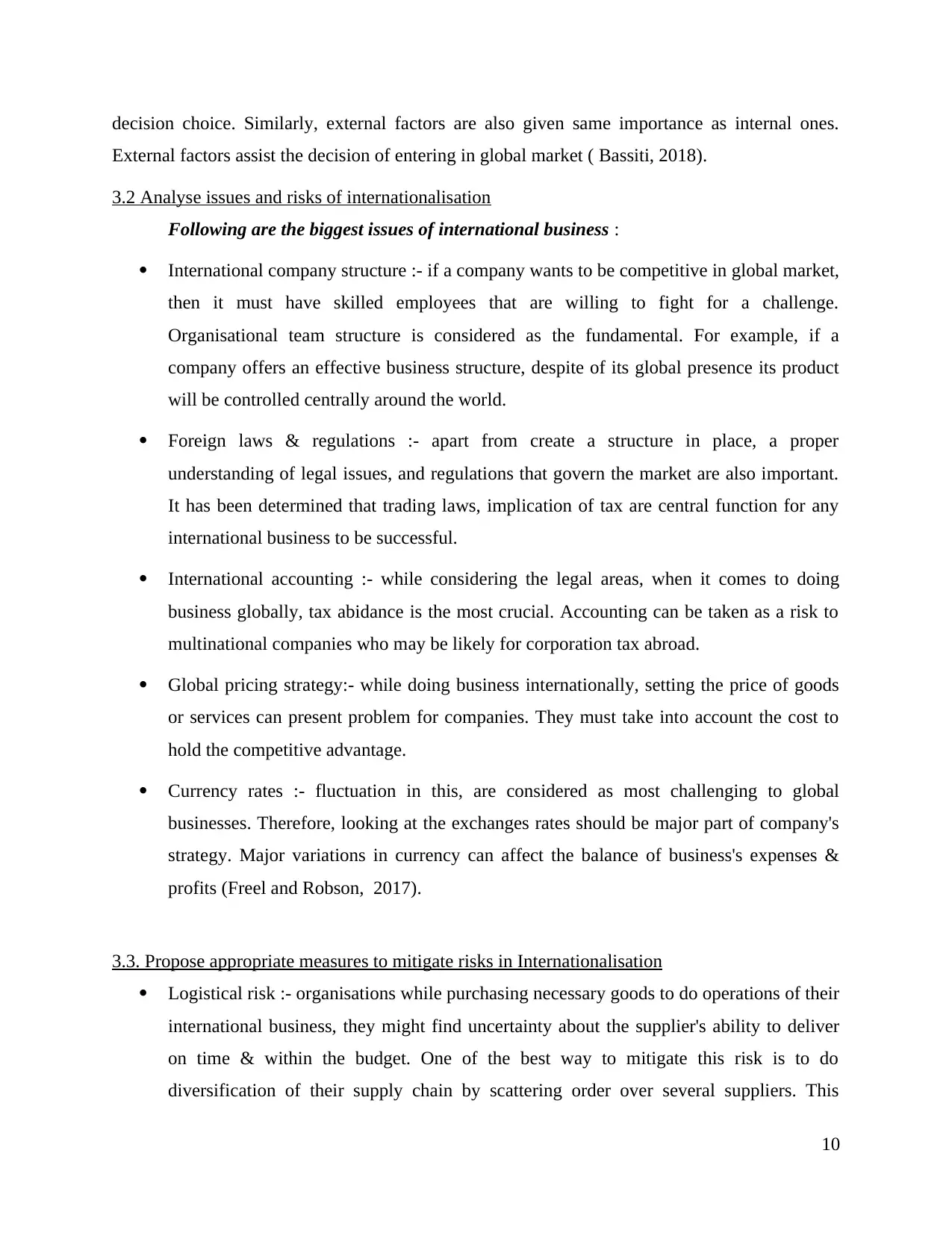
decision choice. Similarly, external factors are also given same importance as internal ones.
External factors assist the decision of entering in global market ( Bassiti, 2018).
3.2 Analyse issues and risks of internationalisation
Following are the biggest issues of international business :
International company structure :- if a company wants to be competitive in global market,
then it must have skilled employees that are willing to fight for a challenge.
Organisational team structure is considered as the fundamental. For example, if a
company offers an effective business structure, despite of its global presence its product
will be controlled centrally around the world.
Foreign laws & regulations :- apart from create a structure in place, a proper
understanding of legal issues, and regulations that govern the market are also important.
It has been determined that trading laws, implication of tax are central function for any
international business to be successful.
International accounting :- while considering the legal areas, when it comes to doing
business globally, tax abidance is the most crucial. Accounting can be taken as a risk to
multinational companies who may be likely for corporation tax abroad.
Global pricing strategy:- while doing business internationally, setting the price of goods
or services can present problem for companies. They must take into account the cost to
hold the competitive advantage.
Currency rates :- fluctuation in this, are considered as most challenging to global
businesses. Therefore, looking at the exchanges rates should be major part of company's
strategy. Major variations in currency can affect the balance of business's expenses &
profits (Freel and Robson, 2017).
3.3. Propose appropriate measures to mitigate risks in Internationalisation
Logistical risk :- organisations while purchasing necessary goods to do operations of their
international business, they might find uncertainty about the supplier's ability to deliver
on time & within the budget. One of the best way to mitigate this risk is to do
diversification of their supply chain by scattering order over several suppliers. This
10
External factors assist the decision of entering in global market ( Bassiti, 2018).
3.2 Analyse issues and risks of internationalisation
Following are the biggest issues of international business :
International company structure :- if a company wants to be competitive in global market,
then it must have skilled employees that are willing to fight for a challenge.
Organisational team structure is considered as the fundamental. For example, if a
company offers an effective business structure, despite of its global presence its product
will be controlled centrally around the world.
Foreign laws & regulations :- apart from create a structure in place, a proper
understanding of legal issues, and regulations that govern the market are also important.
It has been determined that trading laws, implication of tax are central function for any
international business to be successful.
International accounting :- while considering the legal areas, when it comes to doing
business globally, tax abidance is the most crucial. Accounting can be taken as a risk to
multinational companies who may be likely for corporation tax abroad.
Global pricing strategy:- while doing business internationally, setting the price of goods
or services can present problem for companies. They must take into account the cost to
hold the competitive advantage.
Currency rates :- fluctuation in this, are considered as most challenging to global
businesses. Therefore, looking at the exchanges rates should be major part of company's
strategy. Major variations in currency can affect the balance of business's expenses &
profits (Freel and Robson, 2017).
3.3. Propose appropriate measures to mitigate risks in Internationalisation
Logistical risk :- organisations while purchasing necessary goods to do operations of their
international business, they might find uncertainty about the supplier's ability to deliver
on time & within the budget. One of the best way to mitigate this risk is to do
diversification of their supply chain by scattering order over several suppliers. This
10
⊘ This is a preview!⊘
Do you want full access?
Subscribe today to unlock all pages.

Trusted by 1+ million students worldwide
1 out of 20
Related Documents
Your All-in-One AI-Powered Toolkit for Academic Success.
+13062052269
info@desklib.com
Available 24*7 on WhatsApp / Email
![[object Object]](/_next/static/media/star-bottom.7253800d.svg)
Unlock your academic potential
Copyright © 2020–2025 A2Z Services. All Rights Reserved. Developed and managed by ZUCOL.


